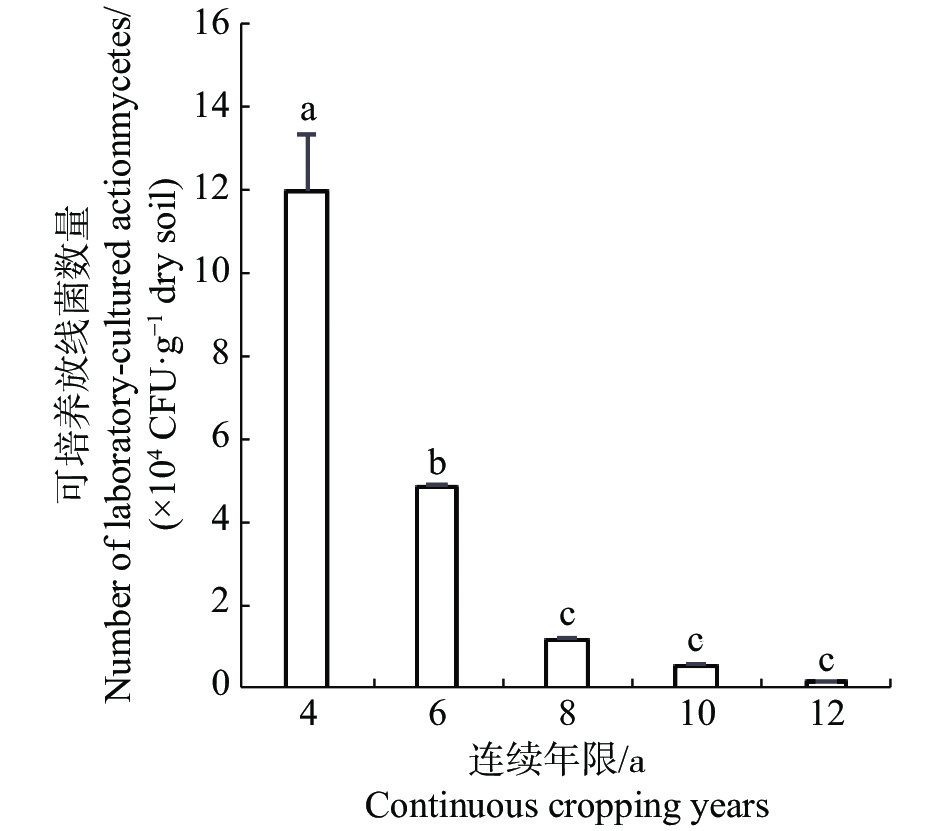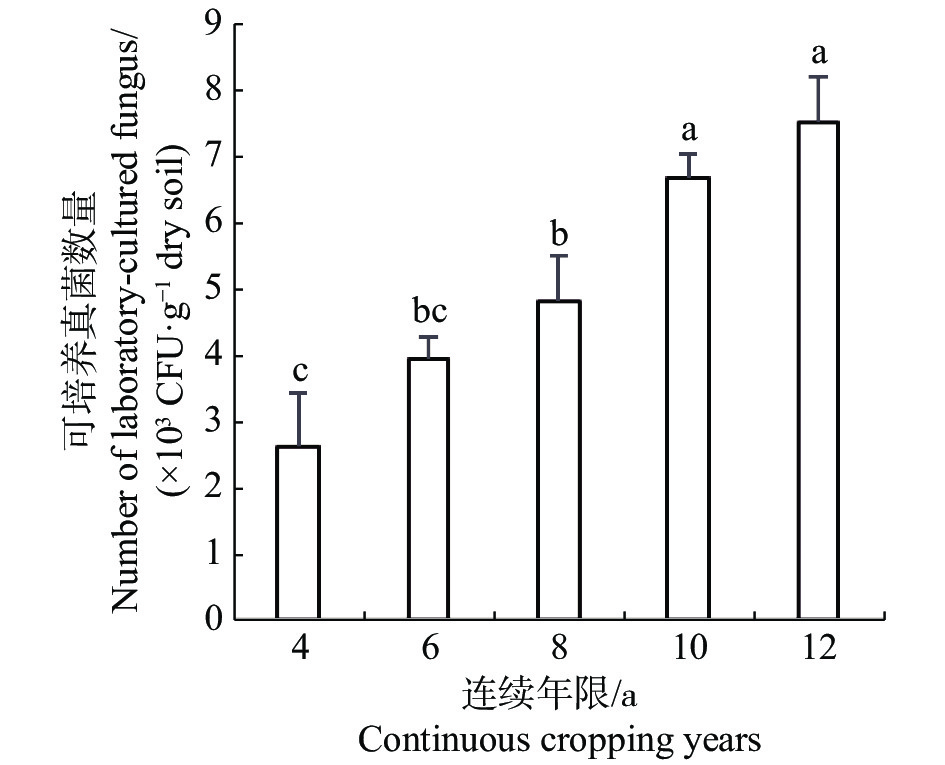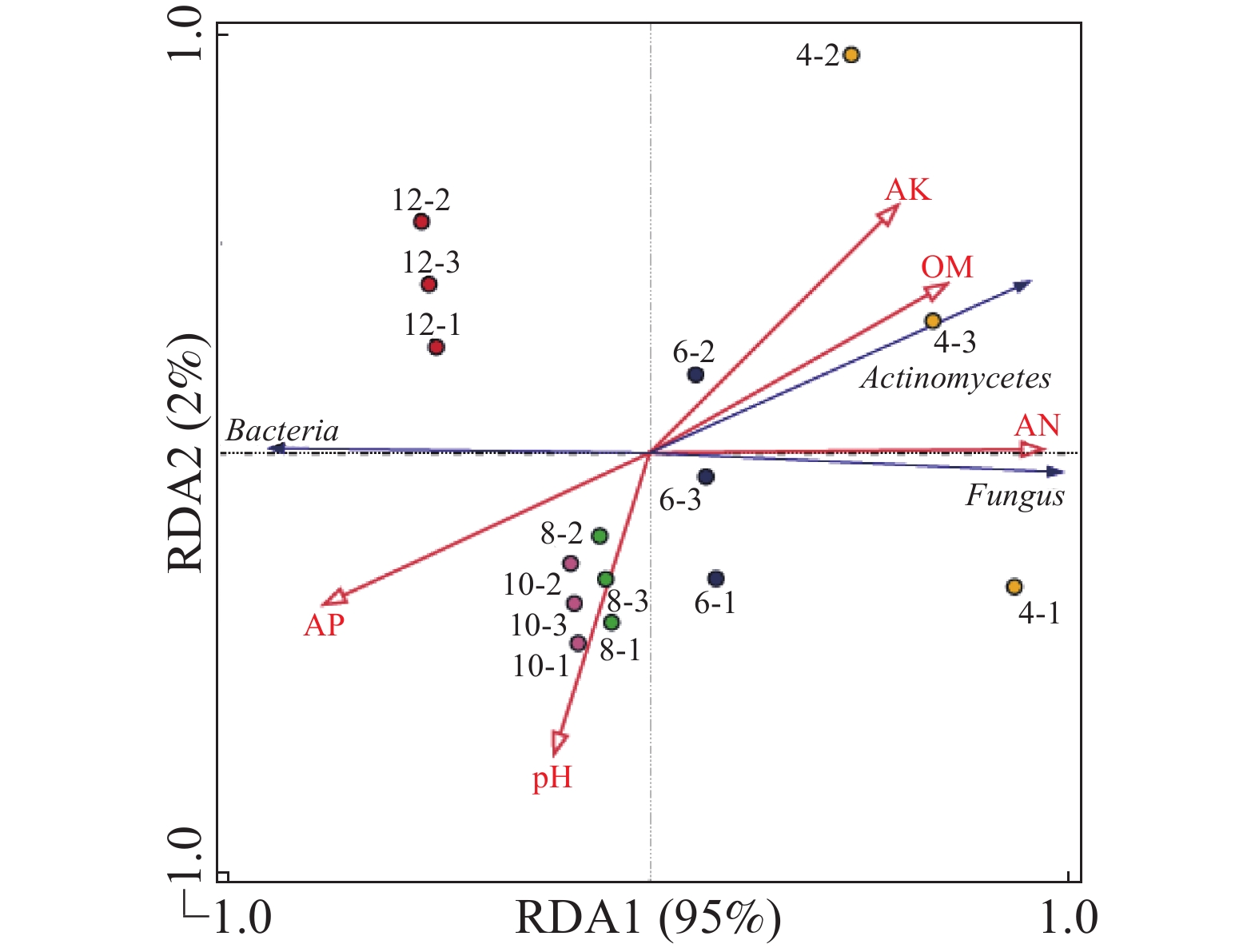-
菠萝(Ananas comosus)作为地位仅次于香蕉的热带水果,在我国主要分布于广东、海南、广西、云南、福建及台湾省等地区[1],海南岛条件优越,菠萝的种植面积为1.67万hm2,占全国的20.4%,产量44万t,占全国的21.94%,是中国的第二大菠萝产区[2]。近几年来,随着菠萝产业迅速发展,菠萝种植面积不断增加,为追求高产,海南省菠萝主要以连作种植模式为主。目前,己有学者对连作菠萝土壤理化性质进行了研究,结果表明,海南菠萝园土壤酸化严重,氮、磷、钾养分不平衡,土壤有机质含量呈下降趋势,导致菠萝园土壤地力退化严重[3-6]。由此可见,菠萝园连作障碍问题已成为限制菠萝生产的重要因素。针对连作障碍的产生机理研究,国内外学者主要对果树、蔬菜等作物进行了研究,发现连作障碍主要由土壤养分不平衡、土壤微生物环境失衡及自毒作用等几个方面引起[7-12]。其中,土壤微生物和土壤养分之间密切相关,土壤养分可作为表征土壤肥力的指标,而土壤微生物数量分布可以敏感地反映土壤肥力变化,可作为评价土壤肥力水平的生物学指标,直接影响土壤养分的有效性和肥力状况[13]。连作障碍的发生与根际微生态失衡有关,连作将使微生物多样性水平降低,造成细菌型土壤向真菌型土壤转化,最终表现为连作障碍[14-15]。刘亚锋等[16]发现,黄瓜连作可减少土壤中可培养微生物数量,其中,细菌数量明显减少,真菌的种类和数量都有很大的变化;黄玉茜等[17]研究花生连作时发现,随着连作年限的增加,花生根际和非根际土壤中细菌、放线菌数量明显减少,而真菌数量明显增加;雷娟利等[18]的研究结果表明,不同蔬菜品种和不同的连作年限导致土壤中细菌种类的组成也发生了明显的变化;SHEN等[19]研究发现,香蕉连作年限与枯萎病发病率正相关,而与产量呈负相关,土壤微生物群落结构发生了明显变化,尤其以真菌更明显。由此可见,连作造成土壤中一些功能细菌的种类和数量发生了相应的变化。因此,研究不同连作年限菠萝园土壤微生物数量的变化情况,对菠萝园土壤肥力衰退研究具有重要意义。
目前,国内外学者主要对海南省菠萝园主产区土壤养分状况进行了研究,而对于不同连作年限菠萝园土壤养分与可培养微生物数量的相关性研究未见报道。因此,为进一步了解海南主产区琼海市菠萝园生产现状,实现菠萝高产高效生产,本研究以海南省主产区琼海市不同连作年限菠萝园土壤为研究对象,分析不同连作年限菠萝园土壤养分与可培养微生物数量指标的变化,旨在了解土壤养分与可培养微生物数量之间的关系,以期为连作菠萝园合理施肥及土壤生态环境的改善提供依据。
HTML
-
土壤样品取自海南省琼海市主产区菠萝园。琼海市位于海南岛东部(110°7′~110°40′E,18°59′~19°29′N),属于热带季风气候区,温差小,年平均气温23~25 ℃,年降雨量2 000~2 500 mm,雨量充沛,雨季旱季分明[20]。供试土壤类型主要是花岗岩发育的砖红壤。
选取连作年限为4、6、8、10、12 a的菠萝园土壤为研究对象,调研区域平均施肥量为N 900 kg·hm−2、P2O5 770 kg·hm−2、K2O 1250 kg·hm−2,常规管理。于2019年7月~ 8月取样,取样土层深度为0~20 cm,对角线5点取样,分别混匀后取500 g土样装袋,注明采集时间与地点,带回实验室,一部分土壤样品用于可培养微生物数量的测定,一部分土壤样品自然风干,过筛处理后用于土壤养分指标的测定,每个处理3次重复。
-
采用重铬酸钾容量法—外加热法测定土壤有机质,碱解扩散法测定土壤碱解氮,盐酸-氟化铵法测定土壤速效磷,乙酸铵提取−火焰光度计法测定速效钾,乙酸铵浸提-原子吸收分光光度法测定交换性钙和交换性镁,水浸提电位法测定土壤pH[21]。
-
采用稀释平板培养法[22]测定土壤可培养细菌、真菌、放线菌数量。细菌采用牛肉膏蛋白胨培养基,30 ℃培养24 h;真菌采用孟加拉红培养基,28 ℃培养72 h;放线菌采用高氏一号培养基,28 ℃培养72 h。然后,计数平板上形成的菌落数,菌落数计算公式如下:
-
土壤养分等级评价:综合第二次全国土壤普查养分分级标准和前人对菠萝园养分评级标准[5-6],对调查采样地块养分状况进行单个测定指标一般性等级评价。具体的土壤养分分级标准见表1。
指标 Index 土壤养分划分标准 Classification of soil nutrients 丰富 High 较丰富 Rather high 中等 Moderate 较缺乏 Rather deficit 缺乏 Deficit 极缺乏 Very deficit 有机质/(g·kg−1) > 40 30~40 20~30 10~20 6~10 < 6 碱解氮/(mg·kg−1) > 150 120~150 90~120 60~90 30~60 < 30 速效钾/(mg·kg−1) > 200 150~200 100~150 50~100 30~50 < 30 速效磷/(mg·kg−1) > 40 20~40 10~20 5~10 3~5 < 3 交换性钙/(mg·kg−1) > 1000 700~1000 500~700 300~500 < 300 交换性镁/(mg·kg−1) > 300 200~300 100~200 50~100 < 50 Table 1. Classification standards for soil nutrients in pineapple orchards
pH> 8.5强碱性,pH7.5~8.5碱性,pH6.5~7.5中性,pH5.5~6.5弱酸性,pH4.5~5.5酸性,pH< 4.5强酸性。
利用Microsoft Excel 2010,IBM SPSS Statistics V21和Canoco5软件进行数据的统计分析和作图。采用Duncan方法分析样品之间的差异性(P<0.05)。采用冗余分析(RDA)研究土壤样品可培养微生物数量和养分指标之间的相关性。
1.1. 供试土壤
1.2. 土壤养分指标的测定
1.3. 土壤可培养微生物数量的测定
1.4. 数据统计分析
-
从表2可以看出,随着连作年限的延长,土壤有机质含量呈下降趋势,其中,连作4 a的菠萝园土壤有机质含量最高,为10.87 g·kg−1,与连作12年菠萝园相比,差异显著(P<0.05);不同连作年限菠萝园土壤碱解氮含量在52.50~147.00 mg·kg−1之间,随着连作年限的延长也呈下降的趋势,其中连作4年土壤碱解氮含量最高,与连作6、8、10、12 a相比,差异显著(P<0.05);土壤速效磷含量在126.64~166.29 mg·kg−1之间,连作4、6、8、10 a土壤速效磷含量呈现上升的趋势,到连作12 a时土壤速效磷含量呈下降趋势;土壤速效钾含量呈先下降再升高的趋势,连作4、6、8、12 a之间差异显著(P<0.05),连作6 a和连作10 a之间差异不显著(P>0.05);土壤pH4.35~5.44,呈先升高后降低的趋势;土壤交换性钙、镁含量则在连作8 a、10 a土壤中积累量最多。
连作年限/
a
Cropping years有机质/
(g·kg−1)
Organic matter碱解氮/
(mg·kg−1)
Alkali-hydrolyzed nitrogen速效磷/
(mg·kg−1)
Available phosphorus速效钾/
(mg·kg−1)
AvailablepotassiumpH 交换性钙/
(mg·kg−1)
Exchangeable calcium交换性镁/
(mg·kg−1)
Exchangeable magnesium4 10.87±2.49a 147.00±7.00a 126.64±0.59d 219.81±3.89a 4.35±0.11d 637.14±0.30c 20.13±0.00c 6 8.76±1.02ab 87.50±3.50b 128.99±0.59d 67.48±0.16d 5.21±0.01b 630.47±0.30c 15.18±0.00d 8 8.82±0.32ab 87.50±3.50b 159.83±0.88b 82.08±2.43c 5.44±0.02a 781.95±0.30b 58.79±0.13b 10 6.23±0.35ab 94.50±3.50b 166.29±0.88a 67.48±0.81d 5.21±0.01b 825.58±1.50a 67.77±0.35a 12 5.88±0.64b 52.50±3.50c 156.31±0.88c 127.51±1.14b 4.45±0.02c 599.27±5.45d 12.57±0.01e 注:同列数据间不同小写字母表示差异显著(P<0.05)。
Notes: Different lowercase letters in the same column indicate significant differences at P<0.05.Table 2. Changes of soil nutrient content in the pineapple orchards with different continuous cropping years
-
从表3中可以看出,不同连作年限土壤pH呈酸性或强酸性。不同连作年限土壤有机质、碱解氮、交换性钙镁含量随着年限的延长呈现缺乏与极缺乏水平,而土壤速效钾含量呈现较缺乏与中等水平,土壤的速效磷含量均达到丰富水平,未出现缺乏水平。
连作年限/
a
Cropping years有机质/
(g·kg−1)
Organic matter碱解氮/
(mg·kg−1)
Alkali-hydrolyzed nitrogen速效磷/
(mg·kg−1)
Available phosphorus速效钾/
(mg·kg−1)
Available potassiumpH 交换性钙/
(mg·kg−1)
Exchangeable calcium交换性镁/
(mg·kg−1)
Exchangeable magnesium4 较缺乏 较丰富 丰富 丰富 强酸性 较缺乏 极缺乏 6 缺乏 较缺乏 丰富 较缺乏 酸性 较缺乏 极缺乏 8 缺乏 较缺乏 丰富 较缺乏 酸性 中等 缺 10 缺乏 中等 丰富 较缺乏 酸性 中等 缺乏 12 极缺乏 极缺乏 丰富 中等 强酸性 较缺乏 极缺乏 Table 3. Evaluation of soil nutrients in the pineapple orchards with different continuous cropping years
-
采用平板计数法对不同连作年限菠萝园土壤可培养微生物进行测定,结果见图1~图3。

Figure 1. Changes in the number of soil bacteria in the pineapple orchards for different continuous cropping years.
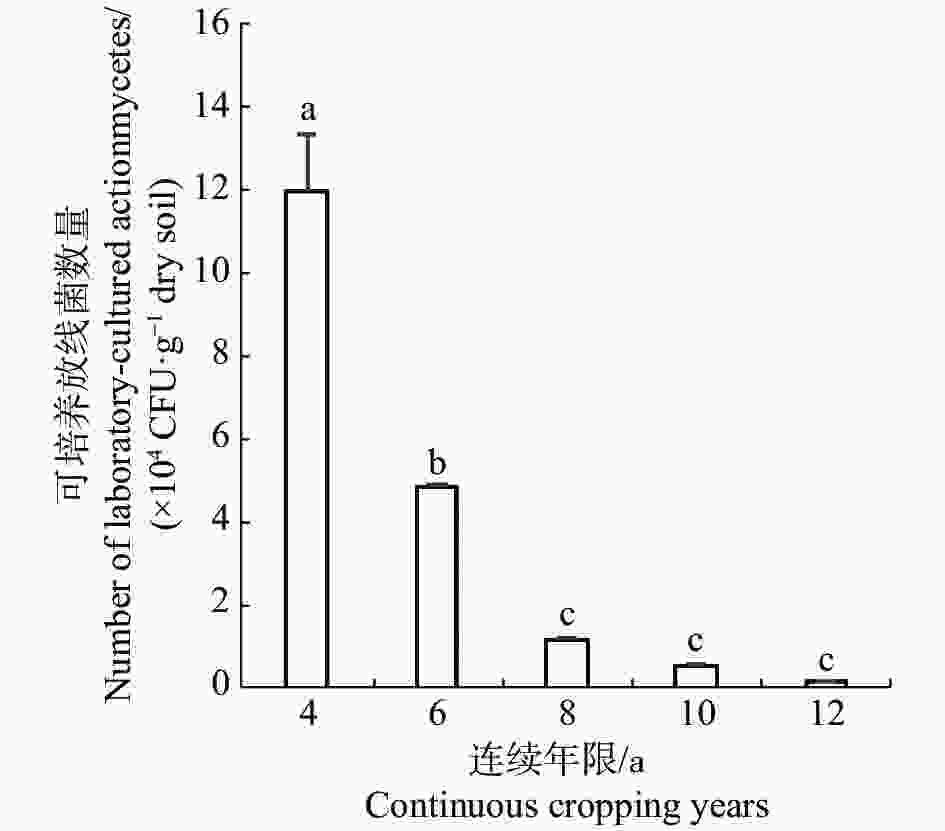
Figure 3. Changes in the number of soil actinomycetes in the pineapple orchards for different continuous cropping years
由图1可知,菠萝园土壤可培养细菌数量随连作年限的增加呈现逐年下降的趋势,连作4 a可培养细菌最多,达到50.21×104 CFU·g−1(干土),连作12 a最低,只有12.71×104 CFU·g−1(干土)。方差分析表明,菠萝园连作4 a的土壤,可培养细菌数量与连作6、8、10、12 a的差异达显著水平(P<0.05),连作6、8 a之间差异不显著。由图2可以看出,菠萝园土壤的可培养真菌数量为2.64×103 CFU·g−1~7.54×103 CFU·g−1。不同连作年限的菠萝园土壤可培养真菌数量的变化趋势与细菌的变化趋势相反。随着连作年限的增加,土壤中真菌的数量呈现上升的趋势。方差分析表明,菠萝园连作4 a的土壤可培养真菌数量与连作8、10、12 a 土壤达到显著差异(P<0.05)。
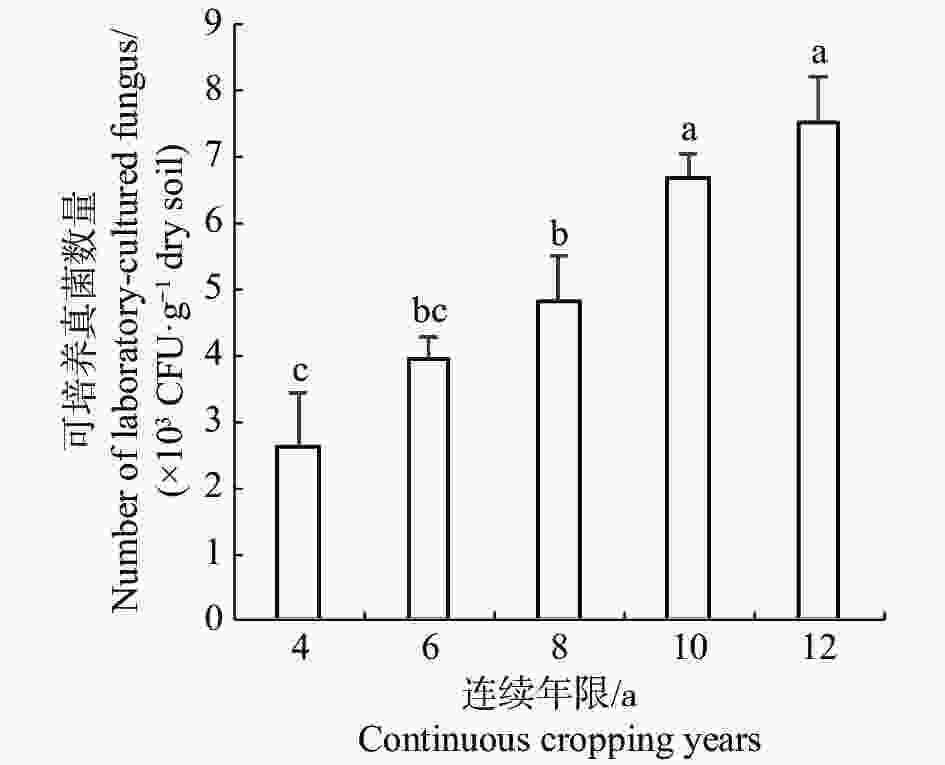
Figure 2. Changes in the number of soil fungi in the pineapple orchards for different continuous cropping years.
由图3可知,随着连作年限的增加,土壤中放线菌可培养数量在连作4、6、8、10、12 a内呈下降的趋势,且在8 a后数量显著下降。方差分析结果表明,8、10、12 a的可培养放线菌数量差异不显著(P>0.05)。
-
利用冗余分析法分析不同连作年限菠萝园土壤养分与可培养微生物数量之间的关系(图4),位于第二象限的可培养细菌数量主要受土壤速效磷与pH的影响,且呈正相关,与土壤速效钾、有机质及碱解氮呈负相关。位于第四象限的可培养真菌数量和位于第一象限的可培养放线菌数量与土壤碱解氮、有机质、速效钾呈正相关,并主要受土壤碱解氮、速效钾的影响。从图4中还可以看出,相同的环境因子在不同的土壤中也存在差异,连作8、10 a的菠萝园土壤样品主要分布在第三象限,说明其主要与土壤速效磷、pH含量有关,且呈正相关。连作4、6 a的菠萝园土壤样品主要分布在第一象限和第四象限,与土壤速效磷、有机质和碱解氮含量呈正相关。连作12年的菠萝园土壤在第二象限,其与土壤环境因子的相关性差于其他土壤样品。
2.1. 不同连作年限菠萝园土壤养分含量的变化
2.2. 不同连作年限菠萝园土壤养分分级评价
2.3. 连作年限对菠萝园土壤可培养微生物数量的影响
2.4. 土壤可培养微生物数量与土壤养分指标相关性分析
-
本研究结果表明,随着连作年限的延长,土壤有机质、碱解氮和速效钾含量呈现下降趋势,这与前人的研究结果相一致[3,6],而土壤有机质含量是土壤肥力的重要指标,造成土壤有机质下降的原因可能是由于菠萝园长期连作,农户有机肥投入少及化肥的施用量过大造成土壤养分耗竭,导致土壤的有机物随着年限的增加越来越少[23]。碱解氮含量下降的原因可能是因为研究区域土壤质地为砂质土,而氮在土壤中的转化和移动性较强,在海南高温多雨条件下,肥料氮可能随着雨水流失或者通过反硝化作用转化损失到空气中,从而导致土壤碱解氮含量越来越少;钾素是菠萝生长需求量最大的养分[24],在研究区域内可能是由于农户施肥时钾供应不足,从而加剧了土壤钾素的耗竭,造成了土壤速效钾含量降低。土壤中速效磷的含量随着连作年限的延长呈现上升趋势,出现明显的富集现象,这一结论与邓阳春等[25] 的研究结果一致,可能是因为研究区域长期施用15-15-15复合肥,而菠萝对磷的需求量低于氮钾,在加上磷元素在土壤中较难移动,易固定[26],因此随着年限的增加土壤中积累了大量的磷素,为了提高磷的生物有效性,需要根据菠萝养分需求特征控制磷肥的供应量,减少土壤对磷的固定。本研究结果还表明,随着年限的延长土壤pH值则呈现降低的趋势,范围在4.35~5.44之间,可能是由于菠萝长期连作过程中,单一施用化肥造成了土壤酸化[27]。
-
本研究结果表明,随着连作年限的增加,土壤细菌、放线菌数量逐渐减少,土壤真菌数量逐渐增加,菠萝连作土壤从“细菌型”转换成“真菌型”。这一结论与李琼芳[28]、李静怡等[29]的研究结果相一致。LARKIN[30]在研究中发现,连作土豆土壤细菌和放线菌数量减少,真菌数量增加,李凯等[31]发现,连作西瓜土壤细菌和放线菌数量减少,真菌数量增加,土壤微生物环境失衡的状态会严重威胁西瓜的品质和产量,这与本研究结论基本相符。
-
土壤微生物参与土壤反应过程,主要通过改善土壤的理化性质等来影响土壤的肥力,土壤微生物的数量在一定程度上反映了土壤的肥力水平[32]。冗余分析结果表明,可培养细菌数量主要受速效磷与pH的影响,刘平静等[33]的研究结果表明,小麦土壤的pH对土壤细菌群落的影响性强,这与本研究结果基本相一致。可培养真菌与放线菌数量与碱解氮、有机质和速效钾含量呈正相关,并主要受碱解氮与速效钾含量影响,这一结论与齐文娟等[34]的研究结果相一致。
目前,海南琼海连作菠萝园土壤速效磷出现了明显的富集,土壤有机质、碱解氮含量随着连作年限的延长逐渐减少,可培养真菌数量逐渐增加,菠萝易发生病害、生长不良。为了使海南菠萝园土壤养分及土壤微生物群落结构平衡,应严格控制化肥的施用,加大有机肥投入,从而提高菠萝园土壤肥力。





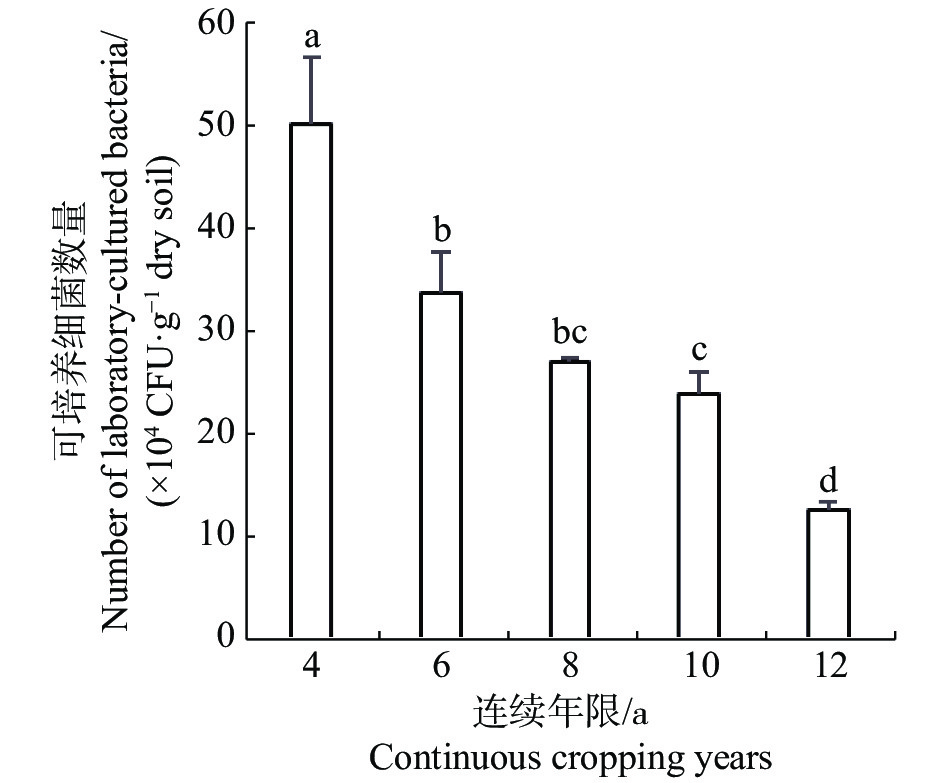

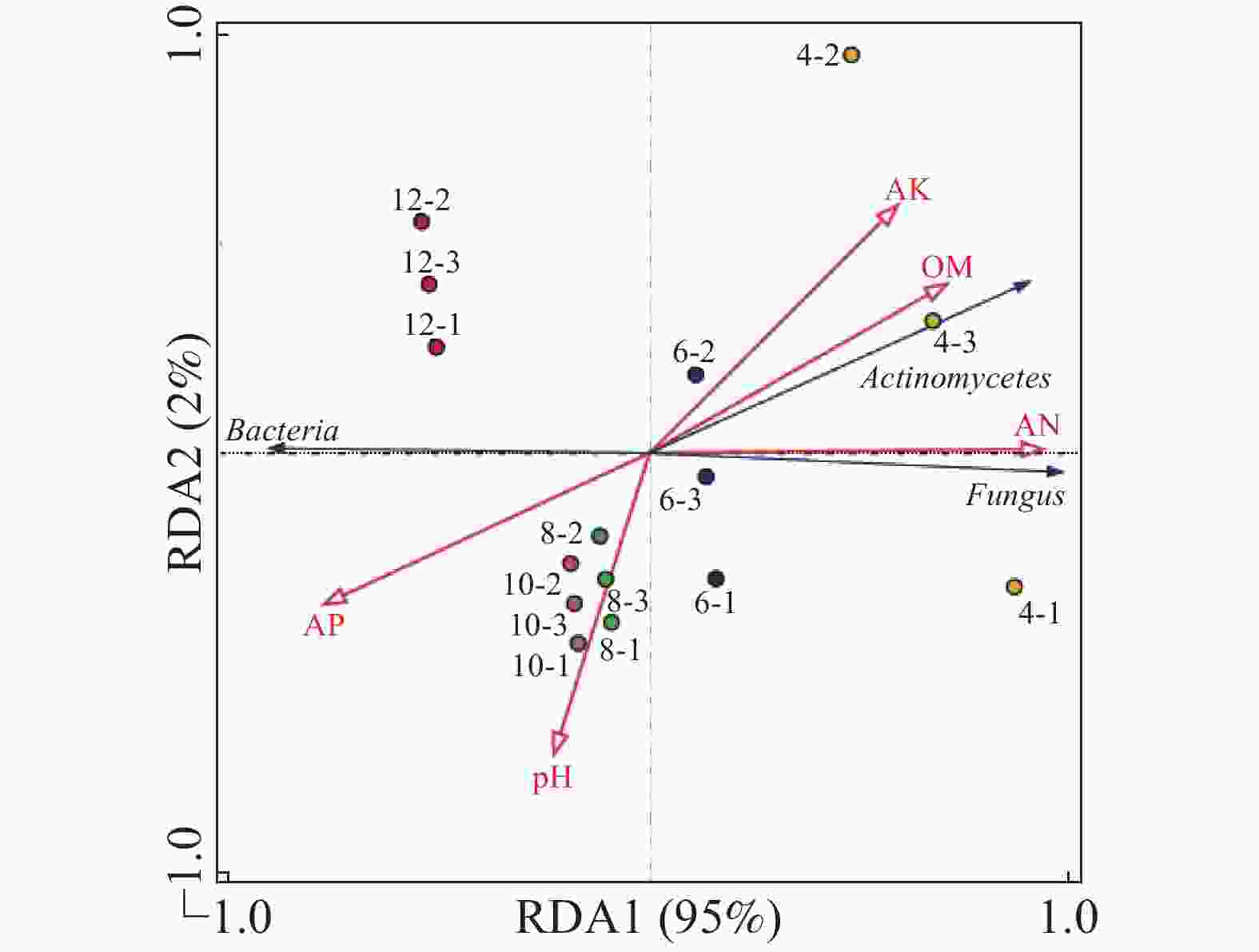
 DownLoad:
DownLoad:
